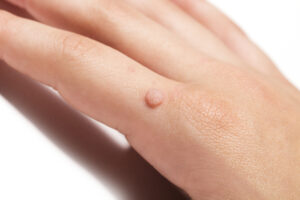 Wart Removal Fayetteville, GA
Wart Removal Fayetteville, GA
The development of warts is a common symptom of a viral infection of the skin, and the growths themselves are harmless. There is a broad spectrum of sizes, shapes, and colors that warts can take on. Small ones are flush with the skin, while the others are somewhat elevated and black. There is a wide variety of wart appearances, from smooth and flat to thick and rough to protruding from the skin. Additionally, they can appear everywhere, although the hands, face, and feet are the most usual areas for this to occur. Contrary to popular belief, warts are not transmitted through contact with amphibians. This is false and perhaps gained traction because of the higher incidence of warts in children than in adults.
It is generally accepted that a viral infection of the skin’s epidermis causes the common wart. It is the human papillomavirus (HPV) family of viruses that are responsible for creating warts. The wart is the result of a viral infection that enters the skin by a scratch, cut, or other injury and stimulates the creation of new cells at the skin’s surface. Over one hundred different varieties of HPV exist, and they are present worldwide. There is a high rate of HPV transmission before people reach maturity, and the vast majority of people will develop at least one wart over their lifetime. The virus causes warts to appear on the hands because it is spread through contact with infected surfaces. Warts are communicable due to the fact that they are caused by a viral infection of the skin. Spreading a wart requires direct contact with the wart or an object that has come into contact with the wart.
Causes of Warts, Fayetteville, GA
In order to develop a wart, the virus that causes them must first penetrate the skin. A minor nick or cut is usually the cause of this. Shaving-related cuts and scrapes are a typical entry point for bacteria. This explains why warts typically appear on men’s faces and necks and on women’s legs. One of the greatest strategies to prevent warts is to keep your skin as clear of nicks and cuts as possible. To avoid cuts, always use a freshly sharpened, brand-new razor. Shaving over a wart can readily transfer the virus to other parts of the body and the razor, therefore it’s important to avoid getting warts in areas where you shave. The best approach to get rid of a wart is to suffocate it with tape or nail polish, then shave around it until it disappears. Although warts aren’t particularly contagious, they can be spread through touching infected skin. In addition to direct contact, the infection can also be spread by contact with contaminated objects or surfaces, such as the soil around a swimming pool. If your skin is damp or broken, you are more susceptible to infection. It may take several weeks or months after infection for a wart or verruca to become visible.
How Do Dermatologists Diagnose Warts, Fayetteville
A dermatologist will be able to diagnose a wart just by looking at it. A skin biopsy is sometimes necessary for a dermatologist to be certain of a diagnosis. The wart will be removed and sent to the lab if a dermatologist determines a biopsy is necessary. A laboratory examination of the wart tissue sample will be performed. A dermatologist can do a biopsy in a short amount of time with minimal risk. This shouldn’t make you nervous in any way. In many cases, warts can be left alone and will disappear. Indeed, this is the case in every case where a child develops a wart. The removal of warts in adults may take longer and be more difficult than it is for kids. Dermatologists can remove most warts even though they don’t usually cause any harm. If your warts won’t go away, are particularly painful, or there are a lot of them, you should consult a dermatologist. Warts can be treated in a variety of ways by dermatologists. The age and general health of the patient, as well as the specific type of wart, all have a role in determining the course of treatment.
Warts can be treated in the dermatologist’s office by “painting” them with cantharidin. A blister forms under the wart after being treated with cantharidin. In about a week, you’ll be able to come back to the dermatologist’s clinic to have the dead wart surgically removed. Typically, adults and older children who have common warts opt for cryotherapy (freezing), which involves removing the wart using liquid nitrogen. It’s not too uncomfortable to undergo this procedure. People with darker skin tones are more likely to get these patches. Recurring therapy is quite usual. Warts on the hands, feet, and face respond well to electrosurgery (burning) and curettage. A wart can be removed via curettage by scraping it off with a sharp knife or a little spoon-shaped tool. It’s not uncommon for doctors to combine these two techniques. A dermatologist may choose to scrape the wart off before or after doing electrosurgery. In some cases, the doctor may remove the wart by surgically slicing it off (excision).
NHCC-National HealthCare Center GA; Fayetteville, GA Skin wart removal
It may seem like new warts appear at the same rate that old ones disappear. That’s what happens if you don’t get rid of your old warts and the virus cells they’ve been shedding into your skin right away. This promotes the growth of more warts in and around the originals. The best approach to avoid this is to get any new warts treated by a dermatologist as soon as possible. For additional details, please get in touch with us at NHCC-National Healthcare Center GA.

